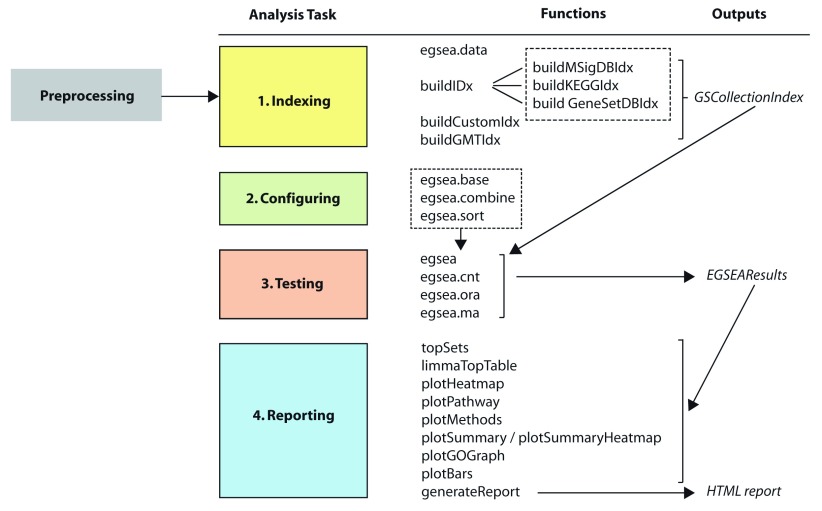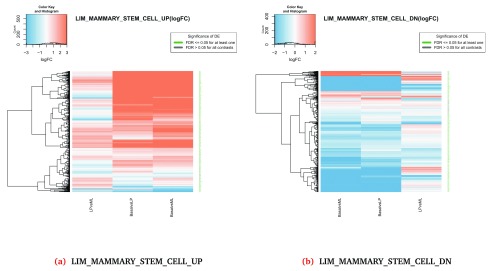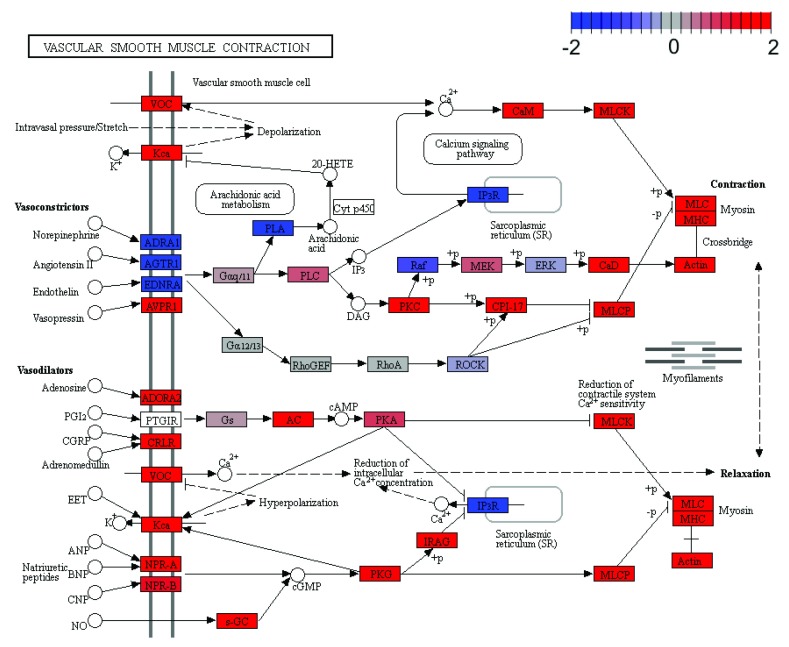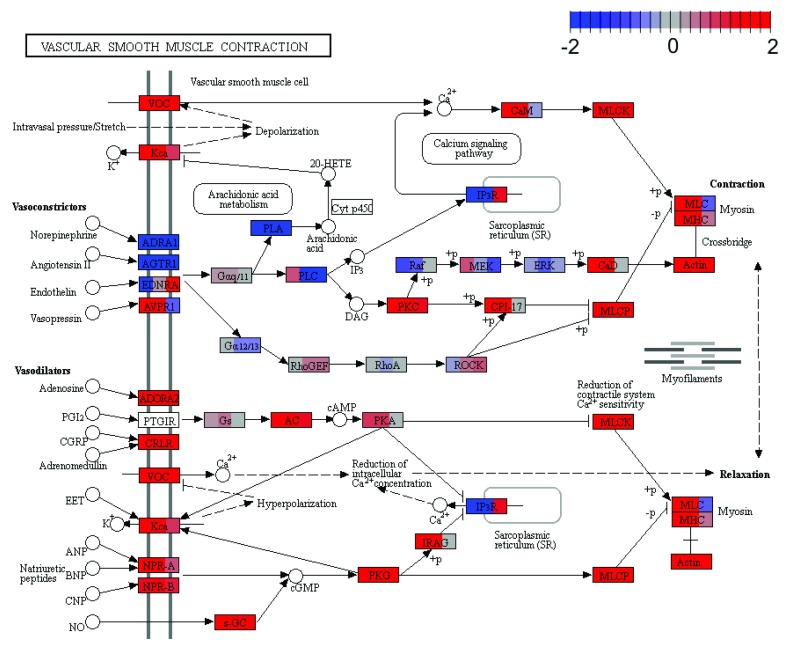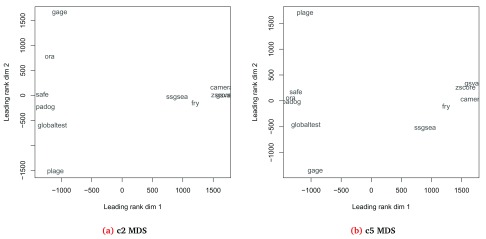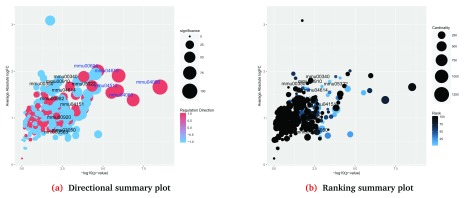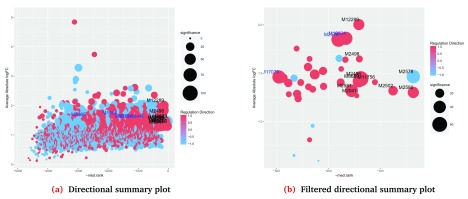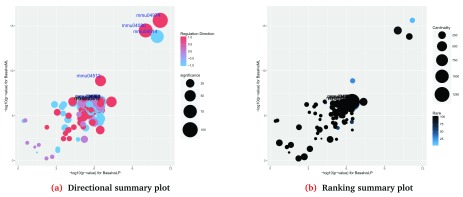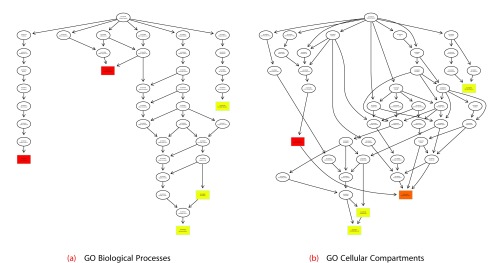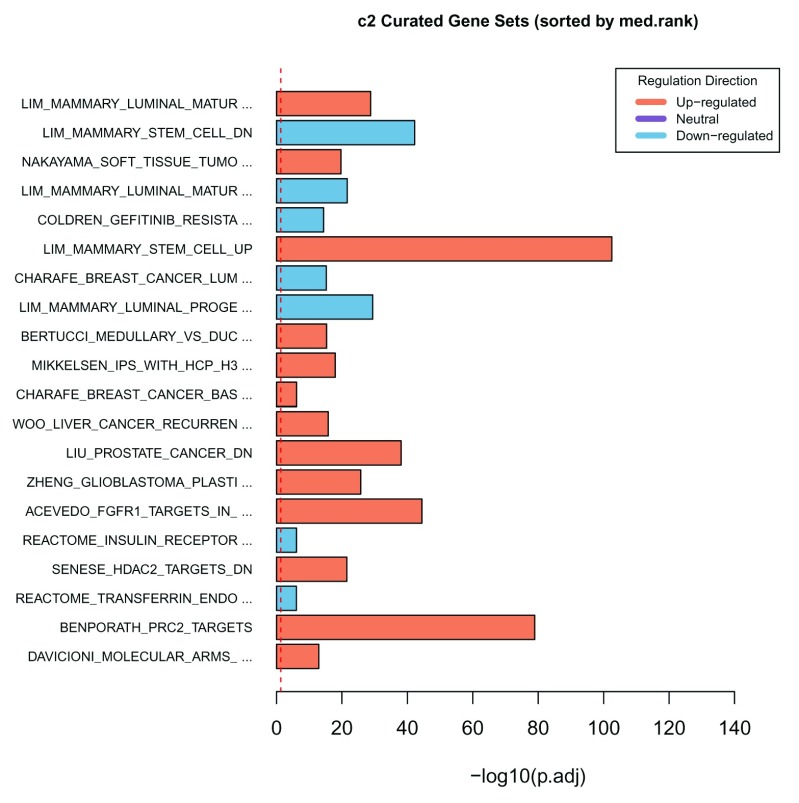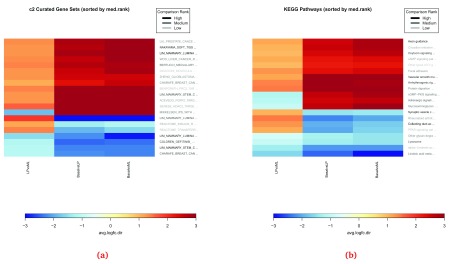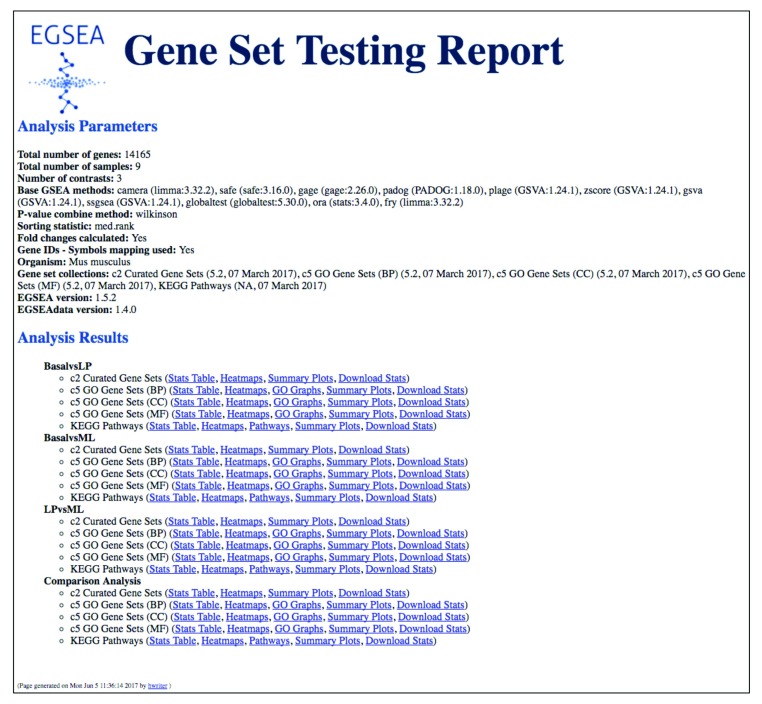Abstract
Gene set enrichment analysis is a popular approach for prioritising the biological processes perturbed in genomic datasets. The Bioconductor project hosts over 80 software packages capable of gene set analysis. Most of these packages search for enriched signatures amongst differentially regulated genes to reveal higher level biological themes that may be missed when focusing only on evidence from individual genes. With so many different methods on offer, choosing the best algorithm and visualization approach can be challenging. The EGSEA package solves this problem by combining results from up to 12 prominent gene set testing algorithms to obtain a consensus ranking of biologically relevant results.This workflow demonstrates how EGSEA can extend limma-based differential expression analyses for RNA-seq and microarray data using experiments that profile 3 distinct cell populations important for studying the origins of breast cancer. Following data normalization and set-up of an appropriate linear model for differential expression analysis, EGSEA builds gene signature specific indexes that link a wide range of mouse or human gene set collections obtained from MSigDB, GeneSetDB and KEGG to the gene expression data being investigated. EGSEA is then configured and the ensemble enrichment analysis run, returning an object that can be queried using several S4 methods for ranking gene sets and visualizing results via heatmaps, KEGG pathway views, GO graphs, scatter plots and bar plots. Finally, an HTML report that combines these displays can fast-track the sharing of results with collaborators, and thus expedite downstream biological validation. EGSEA is simple to use and can be easily integrated with existing gene expression analysis pipelines for both human and mouse data.
Keywords: gene expression, RNA-sequencing, microarrays, gene set enrichment, Bioconductor
Introduction
Gene set enrichment analysis allows researchers to efficiently extract biological insights from long lists of differentially expressed genes by interrogating them at a systems level. In recent years, there has been a proliferation of gene set enrichment (GSE) analysis methods released through the Bioconductor project 1 together with a steady increase in the number of gene set collections available through online databases such as MSigDB 2, GeneSetDB 3 and KEGG 4. In an effort to unify these computational methods and knowledge-bases, the EGSEA R/Bioconductor package was developed. EGSEA, which stands for Ensemble of Gene Set Enrichment Analyses 5 combines the results from multiple algorithms to arrive at a consensus gene set ranking to identify biological themes and pathways perturbed in an experiment. EGSEA calculates seven statistics to combine the individual gene set statistics of base GSE methods to rank biologically relevant gene sets. The current version of the EGSEA package 6 utilizes the analysis results of up to twelve prominent GSE algorithms that include: ora 7, globaltest 8, plage 9, safe 10, zscore 11, gage 12, ssgsea 13, padog 14, gsva 15, camera 16, roast 17 and fry 17. The ora, gage, camera and gsva methods depend on a competitive null hypothesis which assumes the genes in a set do not have a stronger association with the experimental condition compared to randomly chosen genes outside the set. The remaining eight methods are based on a self-contained null hypothesis that only considers genes within a set and again assumes that they have no association with the experimental condition.
EGSEA provides access to a diverse range of gene signature collections through the EGSEAdata package that includes more than 25,000 gene sets for human and mouse organised according to their database sources ( Table 1). For example, MSigDB 2 includes a number of collections (Hallmark (h) and c1–c7) that explore different biological themes ranging from very broad (h, c2, c5) through to more specialised ones focusing on cancer (c4, c6) and immunology (c7). The other main sources are GeneSetDB 3 and KEGG 4 which have similar collections focusing on different biological characteristics ( Table 1). The choice of collection/s in any given analysis should of course be guided by the biological question of interest. The MSigDB c2 and c5 collections are the most widely used in our own analysis practice, spanning a wide range of biological processes and can often reveal new biological insights when applied to a given dataset.
Table 1. Summary of the gene set collections available in the EGSEAdata package.
| Database | Collection | Description |
|---|---|---|
| MSigDB | h Hallmarks
c1 Positional c2 Curated c3 Motif c4 Computational c5 GO c6 Oncogenic c7 Immunologic |
Gene sets representing well-defined biological states
or processes that have coherent expression. Gene sets by chromosome and cytogenetic band. Gene sets obtained from a variety of sources, including online pathway databases and the biomedical literature. Gene sets of potential targets regulated by transcription factors or microRNAs. Gene sets defined computationally by mining large collections of cancer-oriented microarray data. Gene sets annotated by Gene Ontology (GO) terms. Gene sets of the major cellular pathways disrupted in cancer. Gene sets representing different cell types and stimulations relevant to the immune system. |
| KEGG | Signalling
Disease Metabolic |
Gene sets obtained from the KEGG database. |
| GeneSetDB | Pathway
Disease Drug Regulation GO Terms |
Gene sets obtained from various online databases. |
The purpose of this article is to demonstrate the gene set testing workflow available in EGSEA on both RNA-seq and microarray data. Each analysis involves four major steps that are summarized in Figure 1: (1) selecting appropriate gene set collections for analysis and building an index that maps between the members of each set and the expression matrix; (2) choosing the base GSE methods to combine and the ranking options; (3) running the EGSEA test and (4) reporting results in various ways to share with collaborators. The EGSEA functions involved in each of these steps are introduced with code examples to demonstrate how they can be deployed as part of a limma differential expression analysis to help with the interpretation of results.
Figure 1. The main steps in an EGSEA analysis and the functions that perform each task.
Gene expression profiling of the mouse mammary gland
The first experiment analysed in this workflow is an RNA-seq dataset from Sheridan et al. (2015) 18 that consists of 3 cell populations (Basal, Luminal Progenitor (LP) and Mature Luminal (ML)) sorted from the mammary glands of female virgin mice. Triplicate RNA samples from each population were obtained in 3 batches and sequenced on an Illumina HiSeq 2000 using a 100 base-pair single-ended protocol. Raw sequence reads from the fastq files were aligned to the mouse reference genome (mm10) using the Rsubread package 19. Next, gene-level counts were obtained using featureCounts 20 based on Rsubread’s built-in mm10 RefSeq-based annotation. The raw data along with further information on experimental design and sample preparation can be downloaded from the Gene Expression Omnibus (GEO, www.ncbi.nlm.nih.gov/geo/) using GEO Series accession number GSE63310 and will be preprocessed according to the RNA-seq workflow published by Law et al. (2016) 21.
The second experiment analysed in this workflow comes from Lim et al. (2010) 22 and is the microarray equivalent of the RNA-seq dataset mentioned above. The same 3 populations (Basal (also referred to as “MaSC-enriched”), LP and ML) were sorted from mouse mammary glands via flow cytometry. Total RNA from 5 replicates of each cell population were hybridised onto 3 Illumina MouseWG-6 v2 BeadChips. The intensity files and chip annotation file available in Illumina’s proprietary formats (IDAT and BGX respectively) can be downloaded from http://bioinf.wehi.edu.au/EGSEA/arraydata.zip. The raw data from this experiment is also available from GEO under Series accession number GSE19446.
Analysis of RNA-seq data with EGSEA
Our RNA-seq analysis follows on directly from the workflow of Law et al. (2016) which performs a differential gene expression analysis on this data set using the Bioconductor packages edgeR 23, limma 24 and Glimma 25 with gene annotation from the Mus.musculus package 26. The limma package offers a well-developed suite of statistical methods for dealing with differential expression for both microarray and RNA-seq datasets and will be used in the analyses of both datasets presented in this workflow.
Reading, preprocessing and normalisation of RNA-seq data
To get started with this analysis, download the R data file from http://bioinf.wehi.edu.au/EGSEA/mam.rnaseq.rdata. The code below loads the preprocessed count matrix from Law et al. (2016), performs TMM normalisation 27 on the raw counts, and calculates voom weights for use in comparisons of gene expression between Basal and LP, Basal and ML, and LP and ML populations.
> library(limma)
> library(edgeR)
> load("mam.rnaseq.rdata")
> names(mam.rnaseq.data)
[1] "samples" "counts" "genes"
> dim(mam.rnaseq.data)
[1] 14165 9
> x = calcNormFactors(mam.rnaseq.data, method = "TMM")
> design = model.matrix(~0+x$samples$group+x$samples$lane)
> colnames(design) = gsub("x\\$samples\\$group", "", colnames(design))
> colnames(design) = gsub("x\\$samples\\$lane", "", colnames(design))
> head(design)
Basal LP ML L006 L008
1 0 1 0 0 0
2 0 0 1 0 0
3 1 0 0 0 0
4 1 0 0 1 0
5 0 0 1 1 0
6 0 1 0 1 0
> contr.matrix = makeContrasts(
+ BasalvsLP = Basal-LP,
+ BasalvsML = Basal - ML,
+ LPvsML = LP - ML,
+ levels = colnames(design))
> head(contr.matrix)
Contrasts
Levels BasalvsLP BasalvsML LPvsML
Basal 1 1 0
LP -1 0 1
ML 0 -1 -1
L006 0 0 0
L008 0 0 0
The voom function 28 from the limma package converts counts to log-counts-per-million (log-cpm) and calculates observation-level precision weights. The voom object ( v) contains normalized log-cpm values and gene information used by all of the methods in the EGSEA analysis below. The precision weights stored within v are also used by the camera, roast and fry gene set testing methods.
> v = voom(x, design, plot=FALSE)
> names(v)
[1] "genes" "targets" "E" "weights" "design"
For further information on preprocessing see Law et al. (2016), as a detailed explanation of these steps is beyond the scope of this article.
Gene set testing
The EGSEA algorithm makes use of the voom object ( v), a design matrix ( design) and an optional contrasts matrix ( contr.matrix). The design matrix describes how the samples in the experiment relate to the coefficients estimated by the linear model 29. The contrasts matrix then compares two or more of these coefficients to allow relative assessment of differential expression. Base methods that utilize linear models such as those from limma and GSVA ( gsva, plage, zscore and ssgsea) make use of the design and contrasts matrices directly. For methods that do not support linear models, these two matrices are used to extract the group information for each comparison.
1. Exploring, selecting and indexing gene set collections
The package EGSEAdata includes more than 25,000 gene sets organized in collections depending on their database sources. Summary information about the gene set collections available in EGSEAdata can be displayed as follows:
> library(EGSEAdata)
> egsea.data("mouse")
The following databases are available in EGSEAdata for Mus musculus:
Database name: KEGG Pathways
Version: NA
Download/update date: 07 March 2017
Data source: gage::kegg.gsets()
Supported species: human, mouse, rat
Gene set collections: Signaling, Metabolism, Disease
Related data objects: kegg.pathways
Number of gene sets in each collection for Mus musculus :
Signaling: 132
Metabolism: 89
Disease: 67
Database name: Molecular Signatures Database (MSigDB)
Version: 5.2
Download/update date: 07 March 2017
Data source: http://software.broadinstitute.org/gsea
Supported species: human, mouse
Gene set collections: h, c1, c2, c3, c4, c5, c6, c7
Related data objects: msigdb, Mm.H, Mm.c2, Mm.c3, Mm.c4, Mm.c5, Mm.c6, Mm.c7
Number of gene sets in each collection for Mus musculus :
h Hallmark Signatures: 50
c2 Curated Gene Sets: 4729
c3 Motif Gene Sets: 836
c4 Computational Gene Sets: 858
c5 GO Gene Sets: 6166
c6 Oncogenic Signatures: 189
c7 Immunologic Signatures: 4872
Database name: GeneSetDB Database
Version: NA
Download/update date: 15 January 2016
Data source: http://www.genesetdb.auckland.ac.nz/
Supported species: human, mouse, rat
Gene set collections: gsdbdis, gsdbgo, gsdbdrug, gsdbpath, gsdbreg
Related data objects: gsetdb.human, gsetdb.mouse, gsetdb.rat
Number of gene sets in each collection for Mus musculus :
GeneSetDB Drug/Chemical: 6019
GeneSetDB Disease/Phenotype: 5077
GeneSetDB Gene Ontology: 2202
GeneSetDB Pathway: 1444
GeneSetDB Gene Regulation: 201
Type ?<data object name> to get a specific information
about it, e.g., ?kegg.pathways.
As the output above suggests, users can obtain help on any of the collections using the standard R help ( ?) command, for instance ?Mm.c2 will return more information on the mouse version of the c2 collection from MSigDB. The above information can be returned as a list:
> info = egsea.data("mouse", returnInfo = TRUE)
> names(info)
[1] "kegg" "msigdb" "gsetdb"
> info$msigdb$info$collections
[1] "h" "c1" "c2" "c3" "c4" "c5" "c6" "c7"
To highlight the capabilities of the EGSEA package, the KEGG pathways, c2 (curated gene sets) and c5 (Gene Ontology gene sets) collections from the MSigDB database are selected. Next, an index is built for each gene set collection using the EGSEA indexing functions to link the genes in the different gene set collections to the rows of our RNA-seq gene expression matrix. Indexes for the c2 and c5 collections from MSigDB and for the KEGG pathways are built using the buildIdx function which relies on Entrez gene IDs as its key. In the EGSEAdata gene set collections, Entrez IDs are used as they are widely adopted by the different source databases and tend to be more consistent and robust since there is one identifier per gene in a gene set. It is also relatively easy to convert other gene IDs into Entrez IDs.
> library(EGSEA)
> gs.annots = buildIdx(entrezIDs=v$genes$ENTREZID, species="mouse",
+ msigdb.gsets=c("c2", "c5"), go.part = TRUE)
[1] "Loading MSigDB Gene Sets ... "
[1] "Loaded gene sets for the collection c2 ..."
[1] "Indexed the collection c2 ..."
[1] "Created annotation for the collection c2 ..."
[1] "Loaded gene sets for the collection c5 ..."
[1] "Indexed the collection c5 ..."
[1] "Created annotation for the collection c5 ..."
MSigDB c5 gene set collection has been partitioned into
c5BP, c5CC, c5MF
[1] "Building KEGG pathways annotation object ... "
> names(gs.annots)
[1] "c2" "c5BP" "c5CC" "c5MF" "kegg"
To obtain additional information on the gene set collection indexes, including the total number of gene sets, the version number and date of last revision, the methods summary, show and getSetByName (or getSetByID) can be invoked on an object of class GSCollectionIndex, which stores all of the relevant gene set information, as follows:
> class(gs.annots$c2)
[1] "GSCollectionIndex"
attr(,"package")
[1] "EGSEA"
> summary(gs.annots$c2)
c2 Curated Gene Sets (c2): 4726 gene sets - Version: 5.2, Update date: 07 March 2017
> show(gs.annots$c2)
An object of class "GSCollectionIndex"
Number of gene sets: 4726
Annotation columns: ID, GeneSet, BroadUrl, Description, PubMedID, NumGenes, Contributor
Total number of indexing genes: 14165
Species: Mus musculus
Collection name: c2 Curated Gene Sets
Collection unique label: c2
Database version: 5.2
Database update date: 07 March 2017
> s = getSetByName(gs.annots$c2, "SMID_BREAST_CANCER_LUMINAL_A_DN")
ID: M13072
GeneSet: SMID_BREAST_CANCER_LUMINAL_A_DN
BroadUrl: http://www.broadinstitute.org/gsea/msigdb/cards/SMID_BREAST_CANCER_LUMINAL_A_DN.html
Description: Genes down-regulated in the luminal A subtype of breast cancer.
PubMedID: 18451135
NumGenes: 23/24
Contributor: Jessica Robertson
> class(s)
[1] "list"
> names(s)
[1] "SMID_BREAST_CANCER_LUMINAL_A_DN"
> names(s$SMID_BREAST_CANCER_LUMINAL_A_DN)
[1] "ID" "GeneSet" "BroadUrl" "Description" "PubMedID"
[6] "NumGenes" "Contributor"
Objects of class GSCollectionIndex store for each gene set the Entrez gene IDs in the slot original, the indexes in the slot idx and additional annotation for each set in the slot anno.
> slotNames(gs.annots$c2)
[1] "original" "idx" "anno" "featureIDs" "species"
[6] "name" "label" "version" "date"
Other EGSEA functions such as buildCustomIdx, buildGMTIdx, buildKEGGIdx, buildMSigDBIdx and buildGeneSetDBIdx can be also used to build gene set collection indexes. The functions buildCustomIdx and buildGMTIdx were written to allow users to run EGSEA on gene set collections that may have been curated within a lab or downloaded from public databases and allow use of gene identifiers other than Entrez IDs. Example databases include, ENCODE Gene Set Hub (available from https://sourceforge.net/projects/encodegenesethub/), which is a growing resource of gene sets derived from high quality ENCODE profiling experiments encompassing hundreds of DNase hypersensitivity, histone modification and transcription factor binding experiments 30. Other resources include PathwayCommons ( http://www.pathwaycommons.org/) 31 and the KEGGREST 32 package that provides access to up-to-date KEGG pathways across many species.
2. Configuring EGSEA
Before an EGSEA test is carried out, a few parameters need to be specified. First, a mapping between Entrez IDs and Gene Symbols is created for use by the visualization procedures. This mapping can be extracted from the genes data.frame of the voom object as follows:
> colnames(v$genes)
[1] "ENTREZID" "SYMBOL" "CHR"
> symbolsMap = v$genes[, c(1, 2)]
> colnames(symbolsMap) = c("FeatureID", "Symbols")
> symbolsMap[, "Symbols"] = as.character(symbolsMap[, "Symbols"])
Another important parameter in EGSEA is the list of base GSE methods ( baseMethods in the code below), which determines the individual algorithms that are used in the ensemble testing. The supported base methods can be listed using the function egsea.base as follows:
> egsea.base()
[1] "camera" "roast" "safe" "gage" "padog" "plage"
[7] "zscore" "gsva" "ssgsea" "globaltest" "ora" "fry"
The plage, zscore and ssgsea algorithms are available in the GSVA package and camera, fry and roast are implemented in the limma package 24. The ora method is implemented using the phyper function from the stats package 33, which estimates the hypergeometric distribution for a 2 × 2 contingency table. The remaining algorithms are implemented in Bioconductor packages of the same name. A wrapper function is provided for each individual GSE method to utilize this existing R code and create a universal interface for all methods.
Eleven base methods are selected for our EGSEA analysis: camera, safe, gage, padog, plage, zscore, gsva, ssgsea, globaltest, ora and fry. Fry is a fast approximation of roast that assumes equal gene-wise variances across samples to produce similar p-values to a roast analysis run with an infinite number of rotations, and is selected here to save time.
> baseMethods = egsea.base()[-2]
> baseMethods
[1] "camera" "safe" "gage" "padog" "plage" "zscore"
[7] "gsva" "ssgsea" "globaltest" "ora" "fry"
Although, different combinations of base methods might produce different results, it has been found via simulation that including more methods gives better performance 5.
Since each base method generates different p-values, EGSEA supports six different methods from the metap package 34 for combining individual p-values ( Wilkinson 35 is default), which can be listed as follows:
> egsea.combine()
[1] "fisher" "wilkinson" "average" "logitp" "sump" "sumz"
[7] "votep" "median"
Finally, the sorting of EGSEA results plays an essential role in identifying relevant gene sets. Any of EGSEA’s combined scores or the rankings from individual base methods can be used for sorting the results.
> egsea.sort()
[1] "p.value" "p.adj" "vote.rank" "avg.rank" "med.rank"
[6] "min.pvalue" "min.rank" "avg.logfc" "avg.logfc.dir" "direction"
[11] "significance" "camera" "roast" "safe" "gage"
[16] "padog" "plage" "zscore" "gsva" "ssgsea"
[21] "globaltest" "ora" "fry"
Although p.adj is the default option for sorting EGSEA results for convenience, we recommend the use of either med.rank or vote.rank because they efficiently utilize the rankings of individual methods and tend to produce fewer false positives 5.
3. Ensemble testing with EGSEA
Next, the EGSEA analysis is performed using the egsea function that takes a voom object, a contrasts matrix, collections of gene sets and other run parameters as follows:
> gsa = egsea(voom.results=v, contrasts=contr.matrix,
+ gs.annots=gs.annots, symbolsMap=symbolsMap,
+ baseGSEAs=baseMethods, sort.by="med.rank",
+ num.threads = 8, report = FALSE)
EGSEA analysis has started
##------ Fri Jun 16 09:49:11 2017 ------##
Log fold changes are estimated using limma package ...
limma DE analysis is carried out ...
Number of used cores has changed to 3
in order to avoid CPU overloading.
EGSEA is running on the provided data and c2 collection
EGSEA is running on the provided data and c5BP collection
EGSEA is running on the provided data and c5CC collection
EGSEA is running on the provided data and c5MF collection
EGSEA is running on the provided data and kegg collection
##------ Fri Jun 16 09:57:56 2017 ------##
EGSEA analysis took 525.812 seconds.
EGSEA analysis has completed
In situations where the design matrix includes an intercept, a vector of integers that specify the columns of the design matrix to test using EGSEA can be passed to the contrasts argument. If this parameter is NULL, all pairwise comparisons based on v$targets$group are created, assuming that group is the primary factor in the design matrix. Likewise, all the coefficients of the primary factor are used if the design matrix has an intercept.
EGSEA is implemented with parallel computing features enabled using the parallel package 33 at both the method-level and experimental contrast-level. The running time of the EGSEA test depends on the base methods selected and whether report generation is enabled or not. The latter significantly increases the run time, particularly if the argument display.top is assigned a large value (> 20) and/or a large number of gene set collections are selected. EGSEA reporting functionality generates set-level plots for the top gene sets as well as collection-level plots.
The EGSEA package also has a function named egsea.cnt, that can perform the EGSEA test using an RNA-seq count matrix rather than a voom object, a function named egsea.ora, that can perform over-representation analysis with EGSEA reporting capabilities using only a vector of gene IDs, and the egsea.ma function that can perform EGSEA testing using a microarray expression matrix as shown later in the workflow.
Classes used to manage the results. The output of the functions egsea, egsea.cnt, egsea.ora and egsea.ma is an S4 object of class EGSEAResults. Several S4 methods can be invoked to query this object. For example, an overview of the EGSEA analysis can be displayed using the show method as follows:
> show(gsa)
An object of class "EGSEAResults"
Total number of genes: 14165
Total number of samples: 9
Contrasts: BasalvsLP, BasalvsML, LPvsML
Base GSE methods: camera (limma:3.32.2), safe (safe:3.16.0), gage (gage:2.26.0), padog (PADOG:1.18.0), plage (GSVA:1.24.1), zscore (GSVA:1.24.1), gsva (GSVA:1.24.1), ssgsea (GSVA:1.24.1),
P-values combining method: wilkinson
Sorting statistic: med.rank
Organism: Mus musculus
HTML report generated: No
Tested gene set collections:
c2 Curated Gene Sets (c2): 4726 gene sets - Version: 5.2, Update date: 07 March 2017
c5 GO Gene Sets (BP) (c5BP): 4653 gene sets - Version: 5.2, Update date: 07 March 2017
c5 GO Gene Sets (CC) (c5CC): 584 gene sets - Version: 5.2, Update date: 07 March 2017
c5 GO Gene Sets (MF) (c5MF): 928 gene sets - Version: 5.2, Update date: 07 March 2017
KEGG Pathways (kegg): 287 gene sets - Version: NA, Update date: 07 March 2017
EGSEA version: 1.5.2
EGSEAdata version: 1.4.0
Use summary(object) and topSets(object, ...) to explore this object.
This command displays the number of genes and samples that were included in the analysis, the experimental contrasts, base GSE methods, the method used to combine the p-values derived from different GSE algorithms, the sorting statistic used and the size of each gene set collection. Note that the gene set collections are identified using the labels that appear in parentheses (e.g. c2) in the output of show.
4. Reporting EGSEA results
Getting top ranked gene sets. A summary of the top 10 gene sets in each collection for each contrast in addition to the EGSEA comparative analysis can be displayed using the S4 method summary as follows:
> summary(gsa)
**** Top 10 gene sets in the c2 Curated Gene Sets collection ****
** Contrast BasalvsLP **
LIM_MAMMARY_STEM_CELL_DN | LIM_MAMMARY_LUMINAL_PROGENITOR_UP
MONTERO_THYROID_CANCER_POOR_SURVIVAL_UP | SMID_BREAST_CANCER_LUMINAL_A_DN
NAKAYAMA_SOFT_TISSUE_TUMORS_PCA2_UP | REACTOME_LATENT_INFECTION_OF_HOMO_SAPIENS...
REACTOME_TRANSFERRIN_ENDOCYTOSIS_AND_RECYCLING | FARMER_BREAST_CANCER_CLUSTER_2
KEGG_EPITHELIAL_CELL_SIGNALING_... | LANDIS_BREAST_CANCER_PROGRESSION_UP
** Contrast BasalvsML **
LIM_MAMMARY_STEM_CELL_DN | LIM_MAMMARY_STEM_CELL_UP
LIM_MAMMARY_LUMINAL_MATURE_DN | PAPASPYRIDONOS_UNSTABLE_ATEROSCLEROTIC_PLAQUE_DN
NAKAYAMA_SOFT_TISSUE_TUMORS_PCA2_UP | LIM_MAMMARY_LUMINAL_MATURE_UP
CHARAFE_BREAST_CANCER_LUMINAL_VS_MESENCHYMAL_UP | RICKMAN_HEAD_AND_NECK_CANCER_A
YAGUE_PRETUMOR_DRUG_RESISTANCE_DN | BERTUCCI_MEDULLARY_VS_DUCTAL_BREAST_CANCER_DN
** Contrast LPvsML **
LIM_MAMMARY_LUMINAL_MATURE_UP | LIM_MAMMARY_LUMINAL_MATURE_DN
PHONG_TNF_RESPONSE_VIA_P38_PARTIAL | WOTTON_RUNX_TARGETS_UP
WANG_MLL_TARGETS | PHONG_TNF_TARGETS_DN
REACTOME_PEPTIDE_LIGAND_BINDING_RECEPTORS | CHIANG_LIVER_CANCER_SUBCLASS_CTNNB1_DN
GERHOLD_RESPONSE_TO_TZD_DN | DURAND_STROMA_S_UP
** Comparison analysis **
LIM_MAMMARY_LUMINAL_MATURE_DN | LIM_MAMMARY_STEM_CELL_DN
NAKAYAMA_SOFT_TISSUE_TUMORS_PCA2_UP | LIM_MAMMARY_LUMINAL_MATURE_UP
COLDREN_GEFITINIB_RESISTANCE_DN | LIM_MAMMARY_STEM_CELL_UP
CHARAFE_BREAST_CANCER_LUMINAL_VS_MESENCHYMAL_UP | LIM_MAMMARY_LUMINAL_PROGENITOR_UP
BERTUCCI_MEDULLARY_VS_DUCTAL_BREAST_CANCER_DN | MIKKELSEN_IPS_WITH_HCP_H3K27ME3
**** Top 10 gene sets in the c5 GO Gene Sets (BP) collection ****
** Contrast BasalvsLP **
GO_SYNAPSE_ORGANIZATION | GO_IRON_ION_TRANSPORT
GO_CALCIUM_INDEPENDENT_CELL_CELL_ADHESION_VIA_PLASMA_MEMBRANE_CELL_ADHESION_MOLECULES | GO_PH_REDUCTION
GO_HOMOPHILIC_CELL_ADHESION_VIA_PLASMA_MEMBRANE_ADHESION_MOLECULES | GO_VACUOLAR_ACIDIFICATION
GO_FERRIC_IRON_TRANSPORT | GO_TRIVALENT_INORGANIC_CATION_TRANSPORT
GO_NEURON_PROJECTION_GUIDANCE | GO_MESONEPHROS_DEVELOPMENT
** Contrast BasalvsML **
GO_FERRIC_IRON_TRANSPORT | GO_TRIVALENT_INORGANIC_CATION_TRANSPORT
GO_IRON_ION_TRANSPORT | GO_NEURON_PROJECTION_GUIDANCE
GO_GLIAL_CELL_MIGRATION | GO_SPINAL_CORD_DEVELOPMENT
GO_REGULATION_OF_SYNAPSE_ORGANIZATION | GO_ACTION_POTENTIAL
GO_MESONEPHROS_DEVELOPMENT | GO_NEGATIVE_REGULATION_OF_SMOOTH_MUSCLE_CELL_MIGRATION
** Contrast LPvsML **
GO_NEGATIVE_REGULATION_OF_NECROTIC_CELL_DEATH | GO_PARTURITION
GO_RESPONSE_TO_VITAMIN_D | GO_GPI_ANCHOR_METABOLIC_PROCESS
GO_REGULATION_OF_BLOOD_PRESSURE | GO_DETECTION_OF_MOLECULE_OF_BACTERIAL_ORIGIN
GO_CELL_SUBSTRATE_ADHESION | GO_PROTEIN_TRANSPORT_ALONG_MICROTUBULE
GO_INTRACILIARY_TRANSPORT | GO_CELLULAR_RESPONSE_TO_VITAMIN
** Comparison analysis **
GO_IRON_ION_TRANSPORT | GO_FERRIC_IRON_TRANSPORT
GO_TRIVALENT_INORGANIC_CATION_TRANSPORT | GO_NEURON_PROJECTION_GUIDANCE
GO_MESONEPHROS_DEVELOPMENT | GO_SYNAPSE_ORGANIZATION
GO_REGULATION_OF_SYNAPSE_ORGANIZATION | GO_MEMBRANE_DEPOLARIZATION_DURING_CARDIAC_MUSCLE_CELL_ACTION_POTENTIAL
GO_HOMOPHILIC_CELL_ADHESION_VIA_PLASMA_MEMBRANE_ADHESION_MOLECULES | GO_NEGATIVE_REGULATION_OF_SMOOTH_MUSCLE_CELL_MIGRATION
**** Top 10 gene sets in the c5 GO Gene Sets (CC) collection ****
** Contrast BasalvsLP **
GO_PROTON_TRANSPORTING_V_TYPE_ATPASE_COMPLEX | GO_VACUOLAR_PROTON_TRANSPORTING_V_TYPE_ATPASE_COMPLEX
GO_MICROTUBULE_END | GO_MICROTUBULE_PLUS_END
GO_ACTIN_FILAMENT_BUNDLE | GO_CELL_CELL_ADHERENS_JUNCTION
GO_NEUROMUSCULAR_JUNCTION | GO_AP_TYPE_MEMBRANE_COAT_ADAPTOR_COMPLEX
GO_INTERMEDIATE_FILAMENT | GO_CONDENSED_NUCLEAR_CHROMOSOME_CENTROMERIC_REGION
** Contrast BasalvsML **
GO_FILOPODIUM_MEMBRANE | GO_LATE_ENDOSOME_MEMBRANE
GO_PROTON_TRANSPORTING_V_TYPE_ATPASE_COMPLEX | GO_NEUROMUSCULAR_JUNCTION
GO_COATED_MEMBRANE | GO_ACTIN_FILAMENT_BUNDLE
GO_CLATHRIN_COAT | GO_AP_TYPE_MEMBRANE_COAT_ADAPTOR_COMPLEX
GO_CLATHRIN_ADAPTOR_COMPLEX | GO_CONTRACTILE_FIBER
** Contrast LPvsML **
GO_CILIARY_TRANSITION_ZONE | GO_TCTN_B9D_COMPLEX
GO_NUCLEAR_NUCLEOSOME | GO_INTRINSIC_COMPONENT_OF_ORGANELLE_MEMBRANE
GO_ENDOPLASMIC_RETICULUM_QUALITY_CONTROL_COMPARTMENT | GO_KERATIN_FILAMENT
GO_PROTEASOME_COMPLEX | GO_CILIARY_BASAL_BODY
GO_PROTEASOME_CORE_COMPLEX | GO_CORNIFIED_ENVELOPE
** Comparison analysis **
GO_PROTON_TRANSPORTING_V_TYPE_ATPASE_COMPLEX | GO_ACTIN_FILAMENT_BUNDLE
GO_NEUROMUSCULAR_JUNCTION | GO_AP_TYPE_MEMBRANE_COAT_ADAPTOR_COMPLEX
GO_CONTRACTILE_FIBER | GO_INTERMEDIATE_FILAMENT
GO_LATE_ENDOSOME_MEMBRANE | GO_CLATHRIN_VESICLE_COAT
GO_ENDOPLASMIC_RETICULUM_QUALITY_CONTROL_COMPARTMENT | GO_MICROTUBULE_END
**** Top 10 gene sets in the c5 GO Gene Sets (MF) collection ****
** Contrast BasalvsLP **
GO_HYDROGEN_EXPORTING_ATPASE_ACTIVITY | GO_SIGNALING_PATTERN_RECOGNITION_RECEPTOR_ACTIVITY
GO_LIPID_TRANSPORTER_ACTIVITY | GO_TRIGLYCERIDE_LIPASE_ACTIVITY
GO_AMINE_BINDING | GO_STRUCTURAL_CONSTITUENT_OF_MUSCLE
GO_NEUROPEPTIDE_RECEPTOR_ACTIVITY | GO_WIDE_PORE_CHANNEL_ACTIVITY
GO_CATION_TRANSPORTING_ATPASE_ACTIVITY | GO_LIPASE_ACTIVITY
** Contrast BasalvsML **
GO_G_PROTEIN_COUPLED_RECEPTOR_ACTIVITY | GO_TRANSMEMBRANE_RECEPTOR_PROTEIN_KINASE_ACTIVITY
GO_STRUCTURAL_CONSTITUENT_OF_MUSCLE | GO_VOLTAGE_GATED_SODIUM_CHANNEL_ACTIVITY
GO_CORECEPTOR_ACTIVITY | GO_TRANSMEMBRANE_RECEPTOR_PROTEIN_TYROSINE_KINASE_ACTIVITY
GO_LIPID_TRANSPORTER_ACTIVITY | GO_SULFOTRANSFERASE_ACTIVITY
GO_CATION_TRANSPORTING_ATPASE_ACTIVITY | GO_PEPTIDE_RECEPTOR_ACTIVITY
** Contrast LPvsML **
GO_MANNOSE_BINDING | GO_PHOSPHORIC_DIESTER_HYDROLASE_ACTIVITY
GO_BETA_1_3_GALACTOSYLTRANSFERASE_ACTIVITY | GO_COMPLEMENT_BINDING
GO_ALDEHYDE_DEHYDROGENASE_NAD_ACTIVITY | GO_MANNOSIDASE_ACTIVITY
GO_LIGASE_ACTIVITY_FORMING_CARBON_NITROGEN_BONDS | GO_CARBOHYDRATE_PHOSPHATASE_ACTIVITY
GO_LIPASE_ACTIVITY | GO_PEPTIDE_RECEPTOR_ACTIVITY
** Comparison analysis **
GO_STRUCTURAL_CONSTITUENT_OF_MUSCLE | GO_LIPID_TRANSPORTER_ACTIVITY
GO_CATION_TRANSPORTING_ATPASE_ACTIVITY | GO_CHEMOREPELLENT_ACTIVITY
GO_HEPARAN_SULFATE_PROTEOGLYCAN_BINDING | GO_TRANSMEMBRANE_RECEPTOR_PROTEIN_TYROSINE_KINASE_ACTIVITY
GO_LIPASE_ACTIVITY | GO_PEPTIDE_RECEPTOR_ACTIVITY
GO_CORECEPTOR_ACTIVITY | GO_TRANSMEMBRANE_RECEPTOR_PROTEIN_KINASE_ACTIVITY
**** Top 10 gene sets in the KEGG Pathways collection ****
** Contrast BasalvsLP **
Collecting duct acid secretion | alpha-Linolenic acid metabolism
Synaptic vesicle cycle | Hepatitis C
Vascular smooth muscle contraction | Rheumatoid arthritis
cGMP-PKG signaling pathway | Axon guidance
Progesterone-mediated oocyte maturation | Arrhythmogenic right ventricular cardiomyopathy (ARVC)
** Contrast BasalvsML **
Collecting duct acid secretion | Synaptic vesicle cycle
Other glycan degradation | Axon guidance
Arrhythmogenic right ventricular cardiomyopathy (ARVC) | Glycerophospholipid metabolism
Lysosome | Vascular smooth muscle contraction
Protein digestion and absorption | Oxytocin signaling pathway
** Contrast LPvsML **
Glycosylphosphatidylinositol(GPI)-anchor biosynthesis | Histidine metabolism
Drug metabolism - cytochrome P450 | PI3K-Akt signaling pathway
Proteasome | Sulfur metabolism
Renin-angiotensin system | Nitrogen metabolism
Tyrosine metabolism | Systemic lupus erythematosus
** Comparison analysis **
Collecting duct acid secretion | Synaptic vesicle cycle
Vascular smooth muscle contraction | Axon guidance
Arrhythmogenic right ventricular cardiomyopathy (ARVC) | Oxytocin signaling pathway
Lysosome | Adrenergic signaling in cardiomyocytes
Linoleic acid metabolism | cGMP-PKG signaling pathway
EGSEA’s comparative analysis allows researchers to estimate the significance of a gene set across multiple experimental contrasts. This analysis helps in the identification of biological processes that are perturbed in multiple experimental conditions simultaneously. This experiment is the RNA-seq equivalent of Lim et al. (2010) 22, who used Illumina microarrays to study the same cell populations (see later), so it is reassuring to observe the LIM gene signatures derived from this experiment amongst the top ranked c2 gene signatures in both the individual contrasts and comparative results.
Another way of exploring the EGSEA results is to retrieve the top ranked N sets in each collection and contrast using the method topSets. For example, the top 10 gene sets in the c2 collection for the comparative analysis can be retrieved as follows:
> topSets(gsa, gs.label="c2", contrast = "comparison", names.only=TRUE)
Extracting the top gene sets of the collection
c2 Curated Gene Sets for the contrast comparison
Sorted by med.rank
[1] "LIM_MAMMARY_LUMINAL_MATURE_DN"
[2] "LIM_MAMMARY_STEM_CELL_DN"
[3] "NAKAYAMA_SOFT_TISSUE_TUMORS_PCA2_UP"
[4] "LIM_MAMMARY_LUMINAL_MATURE_UP"
[5] "COLDREN_GEFITINIB_RESISTANCE_DN"
[6] "LIM_MAMMARY_STEM_CELL_UP"
[7] "CHARAFE_BREAST_CANCER_LUMINAL_VS_MESENCHYMAL_UP"
[8] "LIM_MAMMARY_LUMINAL_PROGENITOR_UP"
[9] "BERTUCCI_MEDULLARY_VS_DUCTAL_BREAST_CANCER_DN"
[10] "MIKKELSEN_IPS_WITH_HCP_H3K27ME3"
The gene sets are ordered based on their med.rank as selected when egsea was invoked above. When the argument names.only is set to FALSE, additional information is displayed for each gene set including gene set annotation, the EGSEA scores and the individual rankings by each base method. As expected, gene sets retrieved by EGSEA included the LIM gene sets 22 that were derived from microarray profiles of analagous mammary cell populations (sets 1, 2, 4, 6 and 8) as well as those derived from populations with similar origin (sets 7 and 9) and behaviour or characteristics (sets 5 and 10).
Next, topSets can be used to search for gene sets of interest based on different EGSEA scores as well as the rankings of individual methods. For example, the ranking of the six LIM gene sets from the c2 collection can be displayed based on the med.rank as follows:
> t = topSets(gsa, contrast = "comparison",
+ names.only=FALSE, number = Inf, verbose = FALSE)
> t[grep("LIM_", rownames(t)), c("p.adj", "Rank", "med.rank", "vote.rank")]
p.adj Rank med.rank vote.rank
LIM_MAMMARY_LUMINAL_MATURE_DN 1.646053e-29 1 36 5
LIM_MAMMARY_STEM_CELL_DN 6.082053e-43 2 37 5
LIM_MAMMARY_LUMINAL_MATURE_UP 2.469061e-22 4 92 5
LIM_MAMMARY_STEM_CELL_UP 3.154132e-103 6 134 5
LIM_MAMMARY_LUMINAL_PROGENITOR_UP 3.871536e-30 8 180 5
LIM_MAMMARY_LUMINAL_PROGENITOR_DN 2.033005e-06 178 636 115
While five of the LIM gene sets are ranked in the top 10 by EGSEA, the values shown in the median rank ( med.rank) column indicate that individual methods can assign much lower ranks to these sets. EGSEA’s prioritisation of these gene sets demonstrates the benefit of an ensemble approach.
Similarly, we can find the top 10 pathways in the KEGG collection from the ensemble analysis for the Basal versus LP contrast and the comparative analysis as follows:
> topSets(gsa, gs.label="kegg", contrast="BasalvsLP", sort.by="med.rank")
Extracting the top gene sets of the collection
KEGG Pathways for the contrast BasalvsLP
Sorted by med.rank
[1] "Collecting duct acid secretion" "alpha-Linolenic acid metabolism"
[3] "Synaptic vesicle cycle" "Hepatitis C"
[5] "Vascular smooth muscle contraction" "Rheumatoid arthritis"
[7] "cGMP-PKG signaling pathway" "Axon guidance"
[9] "Progesterone-mediated oocyte maturation" "Arrhythmogenic right ventricular cardiomyopathy (ARVC)"
> topSets(gsa, gs.label="kegg", contrast="comparison", sort.by="med.rank")
Extracting the top gene sets of the collection
KEGG Pathways for the contrast comparison
Sorted by med.rank
[1] "Collecting duct acid secretion" "Synaptic vesicle cycle"
[3] "Vascular smooth muscle contraction" "Axon guidance"
[5] "Arrhythmogenic right ventricular cardiomyopathy (ARVC)" "Oxytocin signaling pathway"
[7] "Lysosome" "Adrenergic signaling in cardiomyocytes"
[9] "Linoleic acid metabolism" "cGMP-PKG signaling pathway"
EGSEA highlights many pathways with known importance in the mammary gland such as those associated with distinct roles in lactation like basal cell contraction ( Vascular smooth muscle contraction and Oxytocin signalling pathway) and milk production and secretion from luminal lineage cells ( Collecting duct acid secretion, Synaptic vesicle cycle and Lysosome).
Visualizing results at the gene set level. Graphical representation of gene expression patterns within and between gene sets is an essential part of communicating the results of an analysis to collaborators and other researchers. EGSEA enables users to explore the elements of a gene set via a heatmap using the plotHeatmap method. Figure 2 shows examples for the LIM_MAMMARY_STEM_CELL_UP and LIM_MAMMARY_STEM_CELL_DN signatures which can be visualized across all contrasts using the code below.
Figure 2. Heatmaps of log-fold-changes for genes in the LIM_MAMMARY_STEM_CELL_UP and LIM_MAMMARY_STEM_CELL_DN gene sets across the three experimental comparisons (Basal vs LP, Basal vs ML and LP vs ML).
> plotHeatmap(gsa, gene.set="LIM_MAMMARY_STEM_CELL_UP", gs.label="c2",
+ contrast = "comparison", file.name = "hm_cmp_LIM_MAMMARY_STEM_CELL_UP")
Generating heatmap for LIM_MAMMARY_STEM_CELL_UP from the collection
c2 Curated Gene Sets and for the contrast comparison
> plotHeatmap(gsa, gene.set="LIM_MAMMARY_STEM_CELL_DN", gs.label="c2",
+ contrast = "comparison", file.name = "hm_cmp_LIM_MAMMARY_STEM_CELL_DN")
Generating heatmap for LIM_MAMMARY_STEM_CELL_DN from the collection
c2 Curated Gene Sets and for the contrast comparison
When using plotHeatmap, the gene.set value must match the name returned from the topSets method. The rows of the heatmap represent the genes in the set and the columns represent the experimental contrasts. The heatmap colour-scale ranges from down-regulated (blue) to up-regulated (red) while the row labels (Gene symbols) are coloured in green when the genes are statistically significant in the DE analysis (i.e. FDR ≤ 0.05 in at least one contrast). Heatmaps can be generated for individual comparisons by changing the contrast argument of plotHeatmap. The plotHeatmap method also generates a CSV file that includes the DE analysis results from limma::topTable for all expressed genes in the selected gene set and for each contrast (in the case of contrast = "comparison"). This file can be used to create customised plots using other R/Bioconductor packages.
In addition to heatmaps, pathway maps can be generated for the KEGG gene sets using the plotPathway method which uses functionality from the pathview package 36. For example, the third KEGG signalling pathway retrieved for the contrast BasalvsLP is Vascular smooth muscle contraction and can be visualized as follows:
> plotPathway(gsa, gene.set = "Vascular smooth muscle contraction",
+ contrast = "BasalvsLP", gs.label = "kegg",
+ file.name = "Vascular_smooth_muscle_contraction")
Generating pathway map for Vascular smooth muscle contraction from the collection
KEGG Pathways and for the contrast BasalvsLP
Pathway components are coloured based on the gene-specific log-fold-changes as calculated in the limma DE analysis ( Figure 3). Similarly, a comparative map can be generated for a given pathway across all contrasts.
Figure 3. Pathway map for Vascular smooth muscle contraction (KEGG pathway mmu04270) with log-fold-changes from the Basal vs LP contrast.
> plotPathway(gsa, gene.set = "Vascular smooth muscle contraction",
+ contrast = "comparison", gs.label = "kegg",
+ file.name = "Vascular_smooth_muscle_contraction_cmp")
Generating pathway map for Vascular smooth muscle contraction from the collection
KEGG Pathways and for the contrast comparison
The comparative pathway map shows the log-fold-changes for each gene in each contrast by dividing the gene nodes on the map into multiple columns, one for each contrast ( Figure 4).
Figure 4. Pathway map for Vascular smooth muscle contraction (KEGG pathway mmu04270) with log-fold-changes across three experimental contrasts shown for each gene in the same order left to right that they appear in the contrasts matrix (i.e. Basal vs LP, Basal vs ML and LP vs ML).
Visualizing results at the experiment level. Since EGSEA combines the results from multiple gene set testing methods, it can be interesting to compare how different base methods rank a given gene set collection for a selected contrast. The plotMethods command generates a multi-dimensional scaling (MDS) plot for the ranking of gene sets across all the base methods used ( Figure 5). Methods that rank gene sets similarly will appear closer together in this plot and we see that certain methods consistently cluster together across different gene set collections. The clustering of methods does not necessarily follow the style of null hypothesis tested though (i.e. self-contained versus competitive).
Figure 5.
Multi-dimensional scaling (MDS) plot showing the relationship between different gene set testing methods based on the rankings of the c2 ( a) and c5 ( b) gene sets on the Basal vs LP contrast.
> plotMethods(gsa, gs.label = "c2", contrast = "BasalvsLP",
+ file.name = "mds_c2_BasalvsLP")
Generating MDS plot for the collection
c2 Curated Gene Sets and for the contrast BasalvsLP
> plotMethods(gsa, gs.label = "c5BP", contrast = "BasalvsLP",
+ file.name = "mds_c5_BasalvsLP")
Generating MDS plot for the collection
c5BP GO Gene Sets and for the contrast BasalvsLP
The significance of each gene set in a given collection for a selected contrast can be visualized using EGSEA’s plotSummary method.
> plotSummary(gsa, gs.label = 3, contrast = 3,
+ file.name = "summary_kegg_LPvsML")
Generating Summary plots for the collection
KEGG Pathways and for the contrast LPvsML
The summary plot visualizes the gene sets as bubbles based on the − log 10 ( p- value) (X-axis) and the average absolute log fold-change of the set genes (Y-axis). The sets that appear towards the top-right corner of this plot are most likely to be biologically relevant. EGSEA generates two types of summary plots: the directional summary plot ( Figure 6a), which colours the bubbles based on the regulation direction of the gene set (the direction of the majority of genes), and the ranking summary plot ( Figure 6b), which colours the bubbles based on the gene set ranking in a given collection (according to the sort.by argument). The bubble size is based on the EGSEA significance score in the former plot and the gene set size in the latter. For example, the summary plots of the KEGG pathways for the LP vs ML contrast show few significant pathways ( Figure 6). The blue colour labels on the ranking plot represents gene sets that do not appear in the top 10 gene sets that are selected based on the sort.by argument, yet their EGSEA significance scores are among the top 5 in the entire collection based on the significance score. This is used to identify gene sets with high significance scores that were not captured by the sort.by score. The gene set IDs and more information about each set can be found in the EGSEA HTML report generated later.
Figure 6. Summary plots of the significance of all gene sets in the KEGG collection for the LP vs ML contrast.
By default, plotSummary uses a gene set’s p.adj score for the X-axis. This behaviour can be easily modified by assigning any of the available sort.by scores into the parameter x.axis, for example, med.rank can be used to create an EGSEA summary plot ( Figure 7a) as follows:
Figure 7. Summary plots of the significance of selected gene sets in the c2 collection for the LP vs ML contrast.
The x-axis in each plot is the med.rank. A cut-off of 300 was used to select significant gene sets in the filtered plot ( b).
> plotSummary(gsa, gs.label = 1, contrast = 3,
+ file.name = "summary_c2_LPvsML",
+ x.axis = "med.rank")
Generating Summary plots for the collection
c2 Curated Gene Sets and for the contrast LPvsML
The summary plot tends to become cluttered when the size of the gene set collection is very large as in Figure 7a. The parameter x.cutoff can be used to focus in on the significant gene sets rather than plotting the entire gene set collection, for example ( Figure 7b):
> plotSummary(gsa, gs.label = 1, contrast = 3,
+ file.name = "summary_sig_c2_LPvsML",
+ x.axis = "med.rank", x.cutoff=300)
Generating Summary plots for the collection
c2 Curated Gene Sets and for the contrast LPvsML
Comparative summary plots can be also generated to compare the significance of gene sets between two contrasts, for example, the comparison between Basal vs LP and Basal vs ML ( Figure 8a) shows that most of the KEGG pathways are regulated in the same direction with relatively few pathways regulated in opposite directions (purple coloured bubbles in Figure 8a). Such figures can be generated using the plotSummary method as follows:
Figure 8. Comparative summary plots of the significance of all gene sets in the KEGG collection for the comparison of the contrasts: Basal vs LP and Basal vs ML.
> plotSummary(gsa, gs.label = "kegg", contrast = c(1,2),
+ file.name = "summary_kegg_1vs2")
Generating Summary plots for the collection
KEGG Pathways and for the comparison BasalvsLP vs BasalvsML
The plotSummary method has two useful parameters: (i) use.names that can be used to display gene set names instead of gene set IDs and (ii) interactive that can be used to generate an interactive version of this plot.
The c5 collection of MSigDB and the Gene Ontology collection of GeneSetDB contain Gene Ontology (GO) terms. These collections are meant to be non-redundant, containing only a small subset of the entire GO and visualizing how these terms are related to each other can be informative. EGSEA utilizes functionality from the topGO package 37 to generate GO graphs for the significant biological processes (BPs), cellular compartments (CCs) and molecular functions (MFs). The plotGOGraph method can generate such a display ( Figure 9) as follows:
Figure 9. GO graphs of the top significant GO terms from the c5 gene set collection for the contrast Basal vs LP.
> plotGOGraph(gsa, gs.label="c5BP", contrast = 1, file.name="BasalvsLP-c5BP-top-")
Generating GO Graphs for the collection c5 GO Gene Sets (BP)
and for the contrast BasalvsLP based on the med.rank
> plotGOGraph(gsa, gs.label="c5CC", contrast = 1, file.name="BasalvsLP-c5CC-top-")
Generating GO Graphs for the collection c5 GO Gene Sets (CC)
and for the contrast BasalvsLP based on the med.rank
The GO graphs are coloured based on the values of the argument sort.by, which in this instance was taken as med.rank by default since this was selected when EGSEA was invoked. The top five most significant GO terms are highlighted by default in each GO category (MF, CC or BP). More terms can be displayed by changing the value of the parameter noSig. However, this might generate very complicated and unresolved graphs. The colour of the nodes varies between red (most significant) and yellow (least significant). The values of the sort.by scoring function are scaled between 0 and 1 to generate these graphs.
Another way to visualize results at the experiment level is via a summary bar plot. The method plotBars can be used to generate a bar plot for the top N gene sets in an individual collection for a particular contrast or from a comparative analysis across multiple contrasts. For example, the top 20 gene sets of the comparative analysis carried out on the c2 collection of MSigDB can be visualized in a bar plot ( Figure 10) as follows:
Figure 10. Bar plot of the -log10(p-value) of the top 20 gene sets from the comparative analysis of the c2 collection.
> plotBars(gsa, gs.label = "c2", contrast = "comparison", file.name="comparison-c2-bars")
Generating a bar plot for the collection c2 Curated Gene Sets
and the contrast comparison
The colour of the bars is based on the regulation direction of the gene sets, i.e., red for up-regulated, blue for down-regulated and purple for neutral regulation (in the case of the comparative analysis on experimental contrasts that show opposite behaviours). By default, the − log 10( p. ad j) values are plotted for the top 20 gene sets selected and ordered based on the sort.by parameter. The parameters bar.vals, number and sort.by of plotBars can be changed to customize the bar plot.
When changes over multiple conditions are of interest, a summary heatmap can be a useful visualization. The method plotSummaryHeatmaps generates a heatmap of the top N gene sets in the comparative analysis across all experimental conditions ( Figure 11). By default, 20 gene sets are selected based on the sort.by parameter and the values plotted are the average log-fold changes at the set level for the genes regulated in the same direction as the set regulation direction, i.e. avg.logfc.dir. The parameters number, sort.by and hm.vals of the plotSummaryHeatmaps can be used to customize the summary heatmap. Additionally, the parameter show.vals can be used to display the values of a specific EGSEA score on the heatmap cells. An example summary heatmap can be generated for the MSigDB c2 collection with the following code:
Figure 11.
Summary heatmaps for the top 20 gene sets from the c2 ( a) and KEGG ( b) collections obtained from the EGSEA comparative analysis.
> plotSummaryHeatmap(gsa, gs.label="c2", hm.vals = "avg.logfc.dir",
+ file.name="summary_heatmaps_c2")
Generating summary heatmap for the collection c2 Curated Gene Sets
sort.by: med.rank, hm.vals: avg.logfc.dir, show.vals:
> plotSummaryHeatmap(gsa, gs.label="kegg", hm.vals = "avg.logfc.dir",
+ file.name="summary_heatmaps_kegg")
Generating summary heatmap for the collection KEGG Pathways
sort.by: med.rank, hm.vals: avg.logfc.dir, show.vals:
We find the heatmap view at both the gene set and summary level and the summary level bar plots to be useful summaries to include in publications to highlight the gene set testing results. The top differentially expressed genes from each contrast can be accessed from the EGSEAResults object using the limmaTopTable method.
> t = limmaTopTable(gsa, contrast=1)
> head(t)
ENTREZID SYMBOL CHR logFC AveExpr t P.Value adj.P.Val B
19253 19253 Ptpn18 1 -5.63 4.13 -34.5 5.87e-10 9.62e-07 13.2
16324 16324 Inhbb 1 -4.79 6.46 -33.2 7.99e-10 9.62e-07 13.3
53624 53624 Cldn7 11 -5.51 6.30 -40.2 1.75e-10 9.62e-07 14.5
218518 218518 Marveld2 13 -5.14 4.93 -34.8 5.56e-10 9.62e-07 13.5
12759 12759 Clu 14 -5.44 8.86 -41.0 1.52e-10 9.62e-07 14.7
70350 70350 Basp1 15 -6.07 5.25 -34.3 6.22e-10 9.62e-07 13.3
Creating an HTML report of the results. To generate an EGSEA HTML report for this dataset, you can either set report=TRUE when you invoke egsea or use the S4 method generateReport as follows:
> generateReport(gsa, number = 20, report.dir="./mam-rnaseq-egsea-report")
EGSEA HTML report is being generated ...
The EGSEA report generated for this dataset is available online at http://bioinf.wehi.edu.au/EGSEA/mam-rnaseq-egsea-report/index.html ( Figure 12). The HTML report is a convenient means of organising all of the results generated up to now, from the individual tables to the gene set level heatmaps, pathway maps and summary level plots. It can easily be shared with collaborators to allow them to explore their results more fully. Interactive tables of results via the DT package ( https://CRAN.R-project.org/package=DT) and summary plots from plotly ( https://CRAN.R-project.org/package=plotly) are integrated into the report using htmlwidgets ( https://CRAN.R-project.org/package=htmlwidgets) and can be added by setting interactive = TRUE in the command above. This option significantly increases both the run time and size of the final report due to the large number of gene sets in most collections.
Figure 12. The EGSEA HTML report main page.
This summary page details the analysis parameters (methods combined and ranking options selected) and organises the gene set analysis results by contrast, with further separation by gene set collection. The final section on this page presents results from the comparative analysis. For each contrast and gene set collection analysed, links to tables of results and plots are provided.
This example completes our overview of EGSEA’s gene set testing and plotting capabilities for RNA-seq data. Readers can refer to the EGSEA vignette or individual help pages for further details on each of the above methods and classes.
Analysis of microarray data with EGSEA
The second dataset analysed in this workflow comes from Lim et al. (2010) 22 and is the microarray equivalent of the RNA-seq data analysed above. Support for microarray data is a new feature in EGSEA, and in this example, we show an express route for analysis according to the steps shown in Figure 1, from selecting gene sets and building indexes, to configuring EGSEA, testing and reporting the results. First, the data must be appropriately preprocessed for an EGSEA analysis and to do this we make use of functions available in limma.
Reading, preprocessing and normalisation of microarray data
To analyse this dataset, we begin by unzipping the files downloaded from http://bioinf.wehi.edu.au/EGSEA/arraydata.zip into the current working directory. Illumina BeadArray data can be read in directly using the readIDAT and readBGX functions from the illuminaio package 38. However, a more convenient way is via the read.idat function in limma which uses these illuminaio functions and outputs the data as an EListRaw object for further processing.
> library(limma)
> targets = read.delim("targets.txt", header=TRUE, sep=" ")
> data = read.idat(as.character(targets$File),
+ bgxfile="GPL6887_MouseWG-6_V2_0_R0_11278593_A.bgx",
+ annotation=c("Entrez_Gene_ID","Symbol", "Chromosome"))
Reading manifest file GPL6887_MouseWG-6_V2_0_R0_11278593_A.bgx ... Done
4481850214_B_Grn.idat ... Done
4481850214_C_Grn.idat ... Done
4481850214_D_Grn.idat ... Done
4481850214_F_Grn.idat ... Done
4481850187_A_Grn.idat ... Done
4481850187_B_Grn.idat ... Done
4481850187_D_Grn.idat ... Done
4481850187_E_Grn.idat ... Done
4481850187_F_Grn.idat ... Done
4466975058_A_Grn.idat ... Done
4466975058_B_Grn.idat ... Done
4466975058_C_Grn.idat ... Done
4466975058_D_Grn.idat ... Done
4466975058_E_Grn.idat ... Done
4466975058_F_Grn.idat ... Done
Finished reading data.
> data$other$Detection = detectionPValues(data)
> data$targets = targets
> colnames(data) = targets$Sample
Next the neqc function in limma is used to carry out normexp background correction and quantile normalisation on the raw intensity values using negative control probes 39. This is followed by log 2-transformation of the normalised intensity values and removal of the control probes.
> data = neqc(data)
We then filter out probes that are consistently non-expressed or lowly expressed throughout all samples as they are uninformative in downstream analysis. Our threshold for expression requires probes to have a detection p-value of less than 0.05 in at least 5 samples (the number of samples within each group). We next remove genes without a valid Entrez ID and in cases where there are multiple probes targeting different isoforms of the same gene, select the probe with highest average expression as the representative one to use in the EGSEA analysis. This leaves 7,123 probes for further analysis.
> table(targets$Celltype)
Basal LP ML
5 5 5
> keep.exprs = rowSums(data$other$Detection<0.05)>=5
> table(keep.exprs)
keep.exprs
FALSE TRUE
23638 21643
> data = data[keep.exprs,]
> dim(data)
[1] 21643 15
> head(data$genes)
Probe_Id Array_Address_Id Entrez_Gene_ID Symbol Chromosome
3 ILMN_1219601 2030280 <NA> C920011N12Rik
4 ILMN_1252621 1980164 101142 2700050P07Rik 6
6 ILMN_3162407 6220026 <NA> Zfp36
7 ILMN_2514723 2030072 <NA> 1110067B18Rik
8 ILMN_2692952 6040743 329831 4833436C18Rik 4
9 ILMN_1257952 7160091 <NA> B930060K05Rik
> sum(is.na(data$genes$Entrez_Gene_ID))
[1] 11535
> data1 = data[!is.na(data$genes$Entrez_Gene_ID), ]
> dim(data1)
[1] 10108 15
> ord = order(lmFit(data1)$Amean, decreasing=TRUE)
> ids2keep = data1$genes$Array_Address_Id[ord][!duplicated(data1$genes$Entrez_Gene_ID[ord])]
> data1 = data1[match(ids2keep, data1$genes$Array_Address_Id),]
> dim(data1)
[1] 7123 15
> expr = data1$E
> group = as.factor(data1$targets$Celltype)
> probe.annot = data1$genes[, 2:4]
> head(probe.annot)
> head(probe.annot)
Array_Address_Id Entrez_Gene_ID Symbol
39513 4120224 20102 Rps4x
9062 2260576 22143 Tuba1b
15308 5720202 12192 Zfp36l1
39894 1470600 11947 Atp5b
24709 2710477 20088 Rps24
9872 1580471 228033 Atp5g3
Setting up the linear model for EGSEA testing
As before, we need to set up an appropriate linear model 29 and contrasts matrix to look for differences between the Basal and LP, Basal and ML and LP and ML populations. A batch term is included in the linear model to account for differences in expression that are attributable to the day the experiment was run.
> head(data1$targets)
File Sample Celltype Time Experiment
2-2 4481850214_B_Grn.idat 2-2 ML At1 1
3-3 4481850214_C_Grn.idat 3-3 LP At1 1
4-4 4481850214_D_Grn.idat 4-4 Basal At1 1
6-7 4481850214_F_Grn.idat 6-7 ML At2 1
7-8 4481850187_A_Grn.idat 7-8 LP At2 1
8-9 4481850187_B_Grn.idat 8-9 Basal At2 1
> experiment = as.character(data1$targets$Experiment)
> design = model.matrix(~0 + group + experiment)
> colnames(design) = gsub("group", "", colnames(design))
> design
Basal LP ML experiment2
1 0 0 1 0
2 0 1 0 0
3 1 0 0 0
4 0 0 1 0
5 0 1 0 0
6 1 0 0 0
7 0 0 1 0
8 0 1 0 0
9 1 0 0 0
10 0 0 1 1
11 0 1 0 1
12 1 0 0 1
13 1 0 0 1
14 0 0 1 1
15 0 1 0 1
attr(,"assign")
[1] 1 1 1 2
attr(,"contrasts")
attr(,"contrasts")$group
[1] "contr.treatment"
attr(,"contrasts")$experiment
[1] "contr.treatment"
> contr.matrix = makeContrasts(
+ BasalvsLP = Basal-LP,
+ BasalvsML = Basal-ML,
+ LPvsML = LP-ML,
+ levels = colnames(design))
> contr.matrix
Contrasts
Levels BasalvsLP BasalvsML LPvsML
Basal 1 1 0
LP -1 0 1
ML 0 -1 -1
experiment2 0 0 0
1. Creating gene set collection indexes
We next extract the mouse c2, c5 and KEGG gene signature collections from the EGSEAdata package and build indexes based on Entrez IDs that link between the genes in each signature and the rows of our expression matrix.
> library(EGSEA)
> library(EGSEAdata)
> gs.annots = buildIdx(entrezIDs=probe.annot[, 2],
+ species="mouse",
+ msigdb.gsets=c("c2", "c5"), go.part = TRUE)
[1] "Loading MSigDB Gene Sets ... "
[1] "Loaded gene sets for the collection c2 ..."
[1] "Indexed the collection c2 ..."
[1] "Created annotation for the collection c2 ..."
[1] "Loaded gene sets for the collection c5 ..."
[1] "Indexed the collection c5 ..."
[1] "Created annotation for the collection c5 ..."
MSigDB c5 gene set collection has been partitioned into
c5BP, c5CC, c5MF
[1] "Building KEGG pathways annotation object ... "
> names(gs.annots)
[1] "c2" "c5BP" "c5CC" "c5MF" "kegg"
2. Configuring and 3. Testing with EGSEA
The same 11 base methods used previously in the RNA-seq analysis were selected for the ensemble testing of the microarray data using the function egsea.ma. Gene sets were again prioritised by their median rank across the 11 methods.
> baseMethods = egsea.base()[-2]
> baseMethods
[1] "camera" "safe" "gage" "padog" "plage" "zscore"
[7] "gsva" "ssgsea" "globaltest" "ora" "fry"
>
> gsam = egsea.ma(expr=expr, group=group,
+ probe.annot = probe.annot,
+ design = design,
+ contrasts=contr.matrix,
+ gs.annots=gs.annots,
+ baseGSEAs=baseMethods, sort.by="med.rank",
+ num.threads = 8, report = FALSE)
EGSEA analysis has started
##------ Tue Jun 20 14:27:32 2017 ------##
Log fold changes are estimated using limma package ...
limma DE analysis is carried out ...
Number of used cores has changed to 3
in order to avoid CPU overloading.
EGSEA is running on the provided data and c2 collection
EGSEA is running on the provided data and c5BP collection
EGSEA is running on the provided data and c5CC collection
EGSEA is running on the provided data and c5MF collection
EGSEA is running on the provided data and kegg collection
##------ Tue Jun 20 14:33:37 2017 ------##
EGSEA analysis took 365.359 seconds.
EGSEA analysis has completed
4. Reporting EGSEA results
An HTML report that includes each of the gene set level and summary level plots shown individually for the RNA-seq analysis was then created using the generateReport function. We complete our analysis by displaying the top ranked sets for the c2 collection from a comparative analysis across all contrasts.
> generateReport(gsam, number = 20, report.dir="./mam-ma-egsea-report")
EGSEA HTML report is being generated ...
> topSets(gsam, gs.label="c2", contrast = "comparison", names.only=TRUE, number=5)
Sorted by med.rank
[1] "LIM_MAMMARY_STEM_CELL_UP"
[2] "LIM_MAMMARY_LUMINAL_MATURE_DN"
[3] "LIM_MAMMARY_STEM_CELL_DN"
[4] "CHARAFE_BREAST_CANCER_LUMINAL_VS_MESENCHYMAL_DN"
[5] "LIU_PROSTATE_CANCER_DN"
The EGSEA report generated for this dataset is available online at http://bioinf.wehi.edu.au/EGSEA/mam-ma-egsea-report/index.html. Reanalysis of this data retrieves similar c2 gene sets to those identified by analysis of RNA-seq data. These included the LIM gene signatures (sets 1, 2 and 3) as well as those derived from populations with similar cellular origin (set 4).
Discussion
In this workflow article, we have demonstrated how to use the EGSEA package to combine the results obtained from different gene signature databases across multiple GSE methods to find an ensemble solution. A key benefit of an EGSEA analysis is the detailed and comprehensive HTML report that can be shared with collaborators to help them interpret their data. This report includes tables prioritising gene signatures according to the user specified analysis options, and both gene set specific and summary graphics, each of which can be generated individually using specific R commands. The approach taken by EGSEA is facilitated by the diverse range of gene set testing algorithms and plotting capabilities available within Bioconductor. EGSEA has been tailored to suit a limma-based differential expression analysis which continues to be a very popular and flexible platform for transcriptomic data. Analysts who choose an individual GSE algorithm to prioritise their results rather than an ensemble solution can still benefit from EGSEA’s comprehensive reporting capability.
Software availability
Code to perform this analysis can be found in the EGSEA123 workflow package available from Bioconductor: https://www.bioconductor.org/help/workflows/EGSEA123.
Latest source code is available at: https://github.com/mritchie/EGSEA123.
Archived source code as at the time of publication is available at: https://doi.org/10.5281/zenodo.1043436 40.
Software license: Artistic License 2.0.
Acknowledgements
This material was first trialled in a workshop at the BioC 2017 conference at the Dana Farber Cancer Institute (Boston, MA) on 28 July 2017. We thank the participants at this workshop for their feedback. The authors also thank Dr Alexandra Garnham (The Walter and Eliza Hall Institute of Medical Research) for feedback on this workflow article.
Funding Statement
This work was funded by a National Health and Medical Research Council (NHMRC) Fellowship to MER (GNT1104924), Victorian State Government Operational Infrastructure Support and Australian Government NHMRC IRIISS.
The funders had no role in study design, data collection and analysis, decision to publish, or preparation of the manuscript.
[version 1; referees: 1 approved
References
- 1. Huber W, Carey VJ, Gentleman R, et al. : Orchestrating high-throughput genomic analysis with Bioconductor. Nat Methods. 2015;12(2):115–21. 10.1038/nmeth.3252 [DOI] [PMC free article] [PubMed] [Google Scholar]
- 2. Subramanian A, Tamayo P, Mootha VK, et al. : Gene set enrichment analysis: a knowledge-based approach for interpreting genome-wide expression profiles. Proc Natl Acad Sci U S A. 2005;102(43):15545–50. 10.1073/pnas.0506580102 [DOI] [PMC free article] [PubMed] [Google Scholar]
- 3. Araki H, Knapp C, Tsai P, et al. : GeneSetDB: A comprehensive meta-database, statistical and visualisation framework for gene set analysis. FEBS Open Bio. 2012;2:76–82. 10.1016/j.fob.2012.04.003 [DOI] [PMC free article] [PubMed] [Google Scholar]
- 4. Kanehisa M, Goto S: KEGG: kyoto encyclopedia of genes and genomes. Nucleic Acids Res. 2000;28(1):27–30. 10.1093/nar/28.1.27 [DOI] [PMC free article] [PubMed] [Google Scholar]
- 5. Alhamdoosh M, Ng M, Wilson NJ, et al. : Combining multiple tools outperforms individual methods in gene set enrichment analyses. Bioinformatics. 2017;33(3):414–424. 10.1093/bioinformatics/btw623 [DOI] [PMC free article] [PubMed] [Google Scholar]
- 6. Alhamdoosh M, Ng M, Ritchie ME: EGSEA: Ensemble of Gene Set Enrichment Analyses.R package version 1.5.2.2017. [Google Scholar]
- 7. Tavazoie S, Hughes JD, Campbell MJ, et al. : Systematic determination of genetic network architecture. Nat Genet. 1999;22(3):281–5. 10.1038/10343 [DOI] [PubMed] [Google Scholar]
- 8. Goeman JJ, van de Geer SA, de Kort F, et al. : A global test for groups of genes: testing association with a clinical outcome. Bioinformatics. 2004;20(1):93–9. 10.1093/bioinformatics/btg382 [DOI] [PubMed] [Google Scholar]
- 9. Tomfohr J, Lu J, Kepler TB: Pathway level analysis of gene expression using singular value decomposition. BMC Bioinformatics. 2005;6:225. 10.1186/1471-2105-6-225 [DOI] [PMC free article] [PubMed] [Google Scholar]
- 10. Barry WT, Nobel AB, Wright FA: Significance analysis of functional categories in gene expression studies: a structured permutation approach. Bioinformatics. 2005;21(9):1943–9. 10.1093/bioinformatics/bti260 [DOI] [PubMed] [Google Scholar]
- 11. Lee E, Chuang HY, Kim JW, et al. : Inferring pathway activity toward precise disease classification. PLoS Comput Biol. 2008;4(11):e1000217. 10.1371/journal.pcbi.1000217 [DOI] [PMC free article] [PubMed] [Google Scholar]
- 12. Luo W, Friedman MS, Shedden K, et al. : GAGE: generally applicable gene set enrichment for pathway analysis. BMC Bioinformatics. 2009;10:161. 10.1186/1471-2105-10-161 [DOI] [PMC free article] [PubMed] [Google Scholar]
- 13. Barbie DA, Tamayo P, Boehm JS, et al. : Systematic RNA interference reveals that oncogenic KRAS-driven cancers require TBK1. Nature. 2009;462(7269):108–12. 10.1038/nature08460 [DOI] [PMC free article] [PubMed] [Google Scholar]
- 14. Tarca AL, Draghici S, Bhatti G, et al. : Down-weighting overlapping genes improves gene set analysis. BMC Bioinformatics. 2012;13:136. 10.1186/1471-2105-13-136 [DOI] [PMC free article] [PubMed] [Google Scholar]
- 15. Hänzelmann S, Castelo R, Guinney J: GSVA: gene set variation analysis for microarray and RNA-seq data. BMC Bioinformatics. 2013;14:7. 10.1186/1471-2105-14-7 [DOI] [PMC free article] [PubMed] [Google Scholar]
- 16. Wu D, Smyth GK: Camera: a competitive gene set test accounting for inter-gene correlation. Nucleic Acids Res. 2012;40(17):e133. 10.1093/nar/gks461 [DOI] [PMC free article] [PubMed] [Google Scholar]
- 17. Wu D, Lim E, Vaillant F, et al. : ROAST: rotation gene set tests for complex microarray experiments. Bioinformatics. 2010;26(17):2176–82. 10.1093/bioinformatics/btq401 [DOI] [PMC free article] [PubMed] [Google Scholar]
- 18. Sheridan JM, Ritchie ME, Best SA, et al. : A pooled shRNA screen for regulators of primary mammary stem and progenitor cells identifies roles for Asap1 and Prox1. BMC Cancer. 2015;15(1):221. 10.1186/s12885-015-1187-z [DOI] [PMC free article] [PubMed] [Google Scholar]
- 19. Liao Y, Smyth GK, Shi W: The Subread aligner: fast, accurate and scalable read mapping by seed-and-vote. Nucleic Acids Res. 2013;41(10):e108. 10.1093/nar/gkt214 [DOI] [PMC free article] [PubMed] [Google Scholar]
- 20. Liao Y, Smyth GK, Shi W: featureCounts: an efficient general purpose program for assigning sequence reads to genomic features. Bioinformatics. 2014;30(7):923–30. 10.1093/bioinformatics/btt656 [DOI] [PubMed] [Google Scholar]
- 21. Law CW, Alhamdoosh M, Su S, et al. : RNA-seq analysis is easy as 1-2-3 with limma, Glimma and edgeR [version 2; referees: 3 approved]. F1000Res. 2016;5:1408. 10.12688/f1000research.9005.2 [DOI] [PMC free article] [PubMed] [Google Scholar]
- 22. Lim E, Wu D, Pal B, et al. : Transcriptome analyses of mouse and human mammary cell subpopulations reveal multiple conserved genes and pathways. Breast Cancer Res. 2010;12(2):R21. 10.1186/bcr2560 [DOI] [PMC free article] [PubMed] [Google Scholar]
- 23. Robinson MD, McCarthy DJ, Smyth GK: edgeR: a Bioconductor package for differential expression analysis of digital gene expression data. Bioinformatics. 2010;26(1):139–40. 10.1093/bioinformatics/btp616 [DOI] [PMC free article] [PubMed] [Google Scholar]
- 24. Ritchie ME, Phipson B, Wu D, et al. : limma powers differential expression analyses for RNA-sequencing and microarray studies. Nucleic Acids Res. 2015;43(7):e47. 10.1093/nar/gkv007 [DOI] [PMC free article] [PubMed] [Google Scholar]
- 25. Su S, Law CW, Ah-Cann C, et al. : Glimma: interactive graphics for gene expression analysis. Bioinformatics. 2017;33(13):2050–2. 10.1093/bioinformatics/btx094 [DOI] [PMC free article] [PubMed] [Google Scholar]
- 26. Bioconductor Core Team: Mus.musculus: Annotation package for the Mus.musculus object.R package version 1.3.1.2015. 10.18129/B9.bioc.Mus.musculus [DOI] [Google Scholar]
- 27. Robinson MD, Oshlack A: A scaling normalization method for differential expression analysis of RNA-seq data. Genome Biol. 2010;11(3):R25. 10.1186/gb-2010-11-3-r25 [DOI] [PMC free article] [PubMed] [Google Scholar]
- 28. Law CW, Chen Y, Shi W, et al. : Voom: precision weights unlock linear model analysis tools for RNA-seq read counts. Genome Biol. 2014;15(2):R29. 10.1186/gb-2014-15-2-r29 [DOI] [PMC free article] [PubMed] [Google Scholar]
- 29. Smyth GK: Linear models and empirical Bayes methods for assessing differential expression in microarray experiments. Stat Appl Genet Mol Biol. 2004;3(1):Article 3. 10.2202/1544-6115.1027 [DOI] [PubMed] [Google Scholar]
- 30. Ziemann M, Kaspi A, Rafehi H, et al. : The ENCODE Gene Set Hub. Lorne Genome Conference. 2017. 10.13140/RG.2.2.34302.59208 [DOI] [Google Scholar]
- 31. Cerami EG, Gross BE, Demir E, et al. : Pathway commons, a web resource for biological pathway data. Nucleic Acids Res. 2011;39(Database issue):D685–D690. 10.1093/nar/gkq1039 [DOI] [PMC free article] [PubMed] [Google Scholar]
- 32. Tenenbaum D: KEGGREST: Client-side REST access to KEGG.R package version 1.16.0.2017. [Google Scholar]
- 33. R Core Team: R: A Language and Environment for Statistical Computing.R Foundation for Statistical Computing, Vienna, Austria,2017. Reference Source [Google Scholar]
- 34. Dewey M: metap: meta-analysis of significance values.R package version 0.8.2017. Reference Source [Google Scholar]
- 35. Wilkinson B: A statistical consideration in psychological research. Psychol Bull. 1951;48(3):156–8. 10.1037/h0059111 [DOI] [PubMed] [Google Scholar]
- 36. Luo W, Brouwer C: Pathview: an R/Bioconductor package for pathway-based data integration and visualization. Bioinformatics. 2013;29(14):1830–1. 10.1093/bioinformatics/btt285 [DOI] [PMC free article] [PubMed] [Google Scholar]
- 37. Alexa A, Rahnenfuhrer J: topGO: Enrichment Analysis for Gene Ontology. R package version.2016. 10.18129/B9.bioc.topGO [DOI] [Google Scholar]
- 38. Smith ML, Baggerly KA, Bengtsson H, et al. : illuminaio: an open source idat parsing tool for Illumina microarrays [version 1; referees: 2 approved]. F1000Res. 2013;2:264. 10.12688/f1000research.2-264.v1 [DOI] [PMC free article] [PubMed] [Google Scholar]
- 39. Shi W, Oshlack A, Smyth GK: Optimizing the noise versus bias trade-off for Illumina Whole Genome Expression Beadchips. Nucleic Acids Res. 2010;38(22):e204. 10.1093/nar/gkq871 [DOI] [PMC free article] [PubMed] [Google Scholar]
- 40. mritchie: mritchie/EGSEA123: F1000 Research article version 1 (Version v1). Zenodo. 2017. Data Source [Google Scholar]



